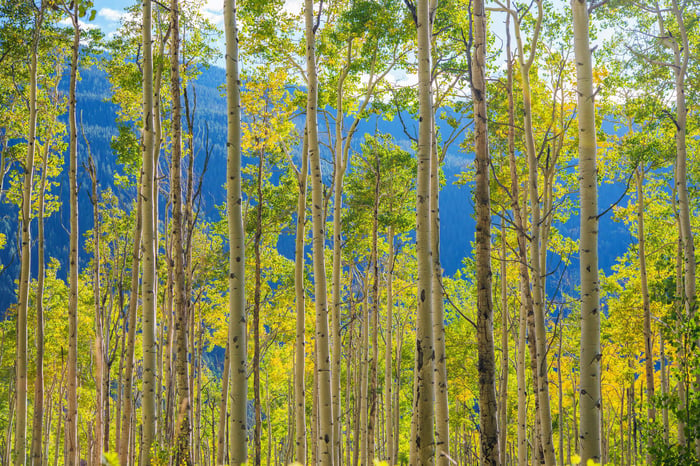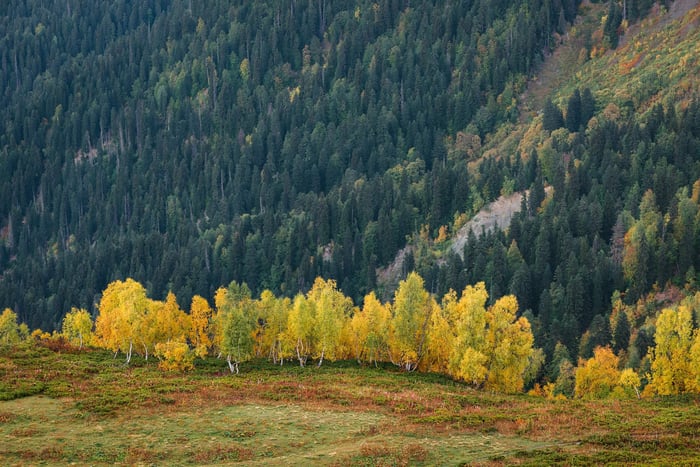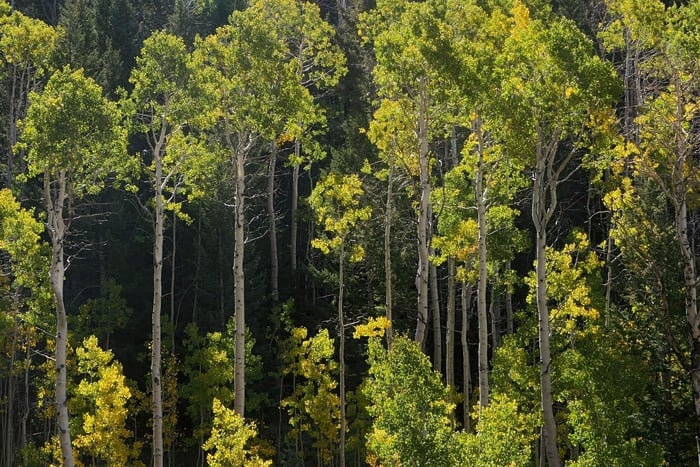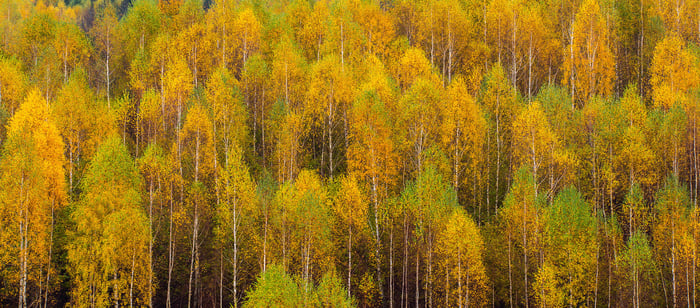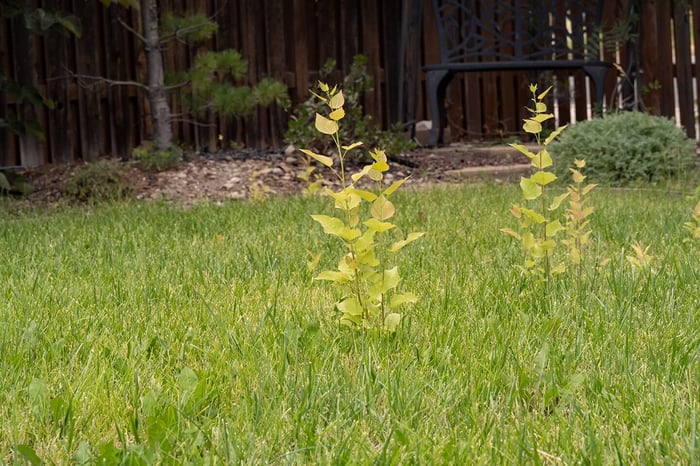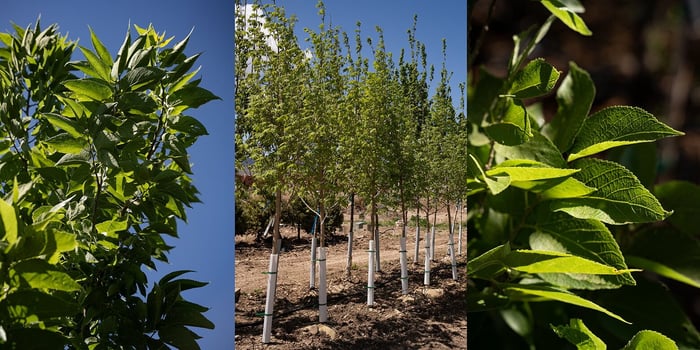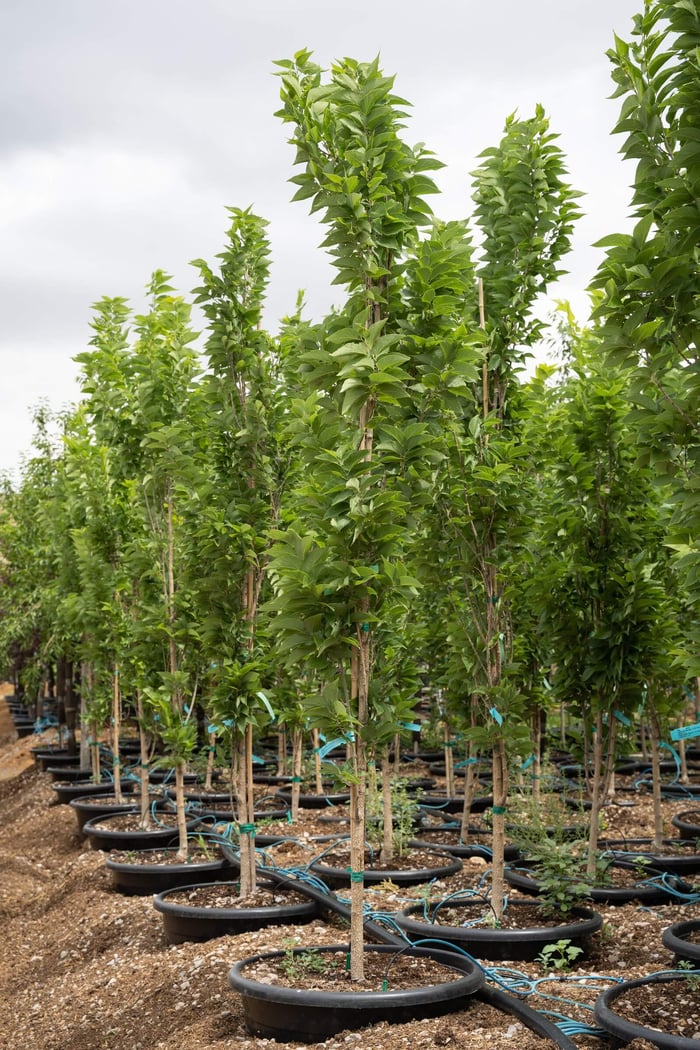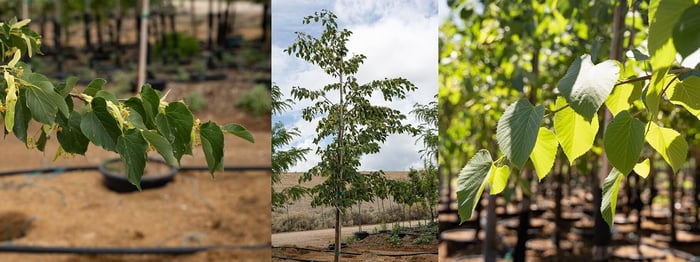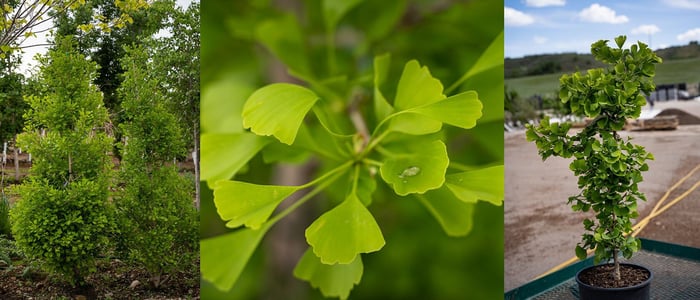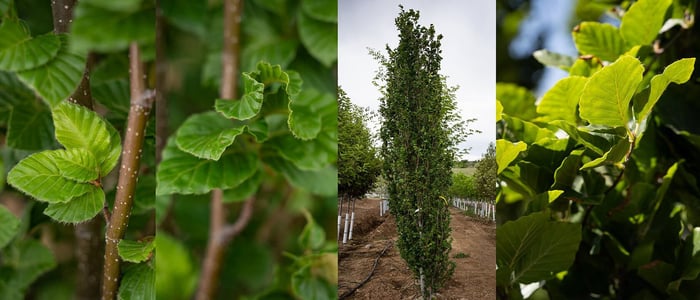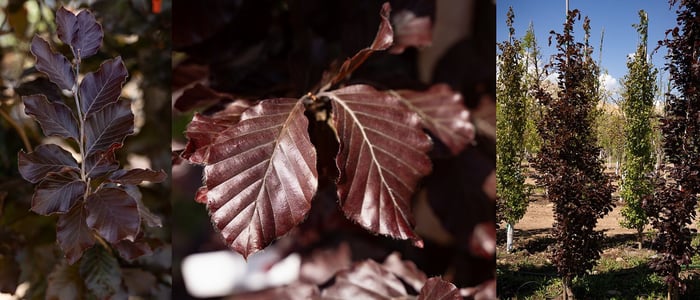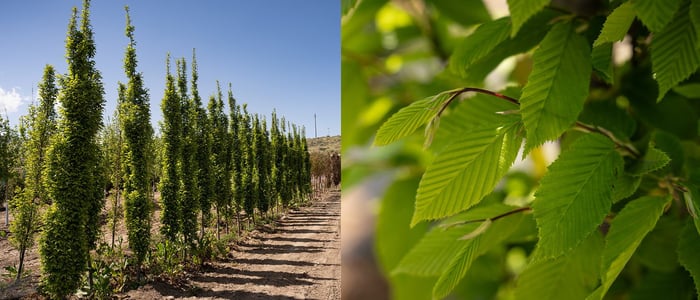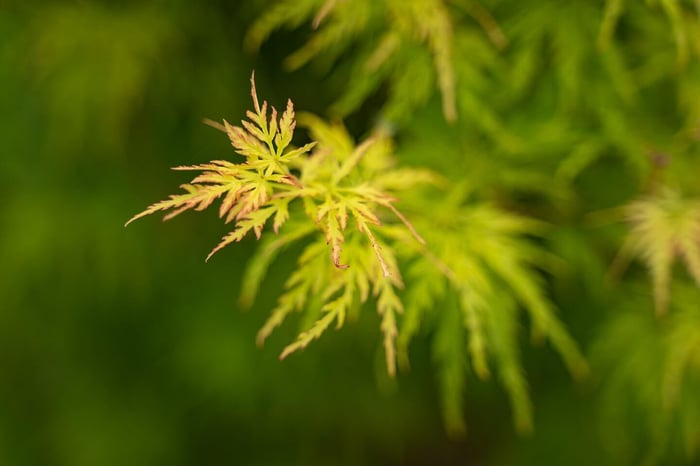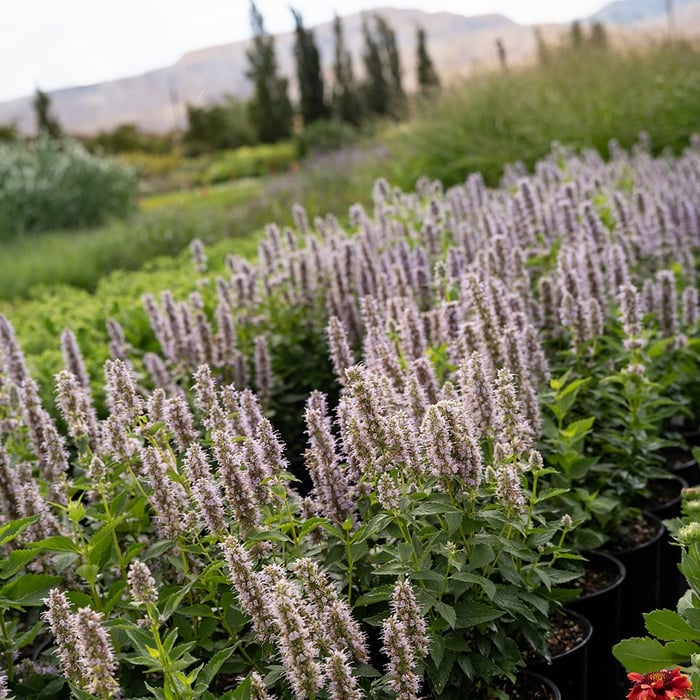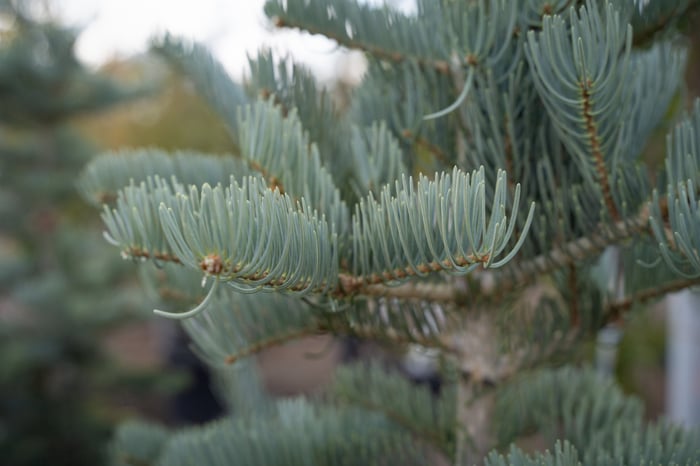Quaking Aspens are some of the most beloved trees in the world. There is nothing quite like them—with their white bark and shimmering leaves that sound like water trickling in a creek. The slightest breeze will turn them into the most fascinating wind chime in your yard. On top of that, they grow quickly and offer wonderful shade in the summer months. So, why are we teaching you how to remove them from your yard?
Quaking Aspens are perfect for the mountains, but they simply aren’t designed to live long in an urban or suburban landscape. They’re a short-lived tree. When was the last time you saw a giant, thick-trunked quaking aspen? That’s simply not how they grow. The average quaking aspen will live anywhere from 15 to 20 years before it succumbs to disease and dies. Well, actually, that’s not exactly true. Quaking aspens may, in fact, be eternal.
As impressive as the aspen tree is, with its white bark and shimmering leaves, its root system is its real super power! Once a quaking aspen has established itself for a year or two, it begins to create a lateral root system. These roots are close to the surface, just under the soil like feeder roots, but their main purpose is quite different from feeder roots of other trees. These roots are designed to sprout new trees, hundreds of them, and each of those new trees will send out lateral roots and sprouts of its own. From one tree, hundreds, perhaps thousands of trees will sprout over the span of just a few decades.
That explains why the largest living single organism in the world is a giant stand of quaking aspen trees right here in Utah. It’s called the Pando aspen clone, an immense clonal colony of quaking aspen trees all connected by a single, massive underground root system. This interconnected network of aspens includes more than 40,000 trees spanning across 106+ acres and is estimated to weigh roughly 13 million pounds! That’s what that cute little quaking aspen you planted in your yard aspires to become, and it will make every effort to do so.
On mountains and hillsides, these expansive root systems are a wonderful way to reduce erosion. These fascinating trees are often buried for months at a time under several feet of snow. As that snow melts in the spring and early summer months, this massive root system helps hold soil in place and reduces mudslides. That soil becomes an ideal place for other forms of plant life. In the mountains, quaking aspens are a key element of stability. In your yard, however, that very source of stability will become an annoyance and even a menace to you and your neighbors!
Removing them from your landscape will not only save your lawn from roots that rob water from your grass, but it will also eliminate intruding trees that interrupt your garden beds, disrupt your lawn, and make it nearly impossible to walk barefoot in your yard. Taking out your aspens may also improve relationships with your neighbors. Chances are, they’re already fighting with sprouts from your trees and just don’t know how to tell you. It’s not quite as bad as having your dog poop on their lawn every day, but it’s pretty close.
What's the best way to get rid of them?
According to the Utah State University Horticulture Specialist, if you have aspens you want to remove from your landscape, there is a right way and a wrong way to do it.
• The wrong way is to simply cut the tree down. If the tree is cut down, the root system responds by sending up a new group of suckers, and may continue to do so for several years. It is almost like the mythical Hydra; for every head you cut off, several more grow back.
• The right way to remove aspen is to kill the tree and the root system with an herbicide and cut it down after it is dead.
• To kill aspens apply the herbicide Roundup to the base of the trunk. The base of the trunk is often called the root flare. It’s the area just above ground where the trunk widens to support the tree. Drill a series of holes into the trunk at a 45 degree angle and fill the holes with concentrated herbicide.
• Another way is to use a sharp hatchet to make a series of shallow, horizontal cuts angled downward through the outer bark and just into the wood. By making one chop with the hatchet and twisting it before removing, a frill is left where the cut bark curls away from the tree. The concentrated herbicide can be poured into these frills and will be absorbed into the tree. Be sure to leave space between your cuts. You don’t want to girdle the tree by cutting a complete ring around the trunk. That will disrupt the flow of nutrients from the tree to the roots and kill it without allowing the tree to pull the herbicide down into its lateral roots.
• The best time to apply this treatment is late summer or early fall before the leaves change color. The tree can then be cut down the following spring.
So there you have it. Expert advice from an experienced source. But then what? What do you replace your aspens with when they’re gone?
New Aspens?
Now that you know how to effectively remove quaking aspen from your yard, you may decide to replace your problem quaking aspens with new aspens. They’ll grow quickly and offer all the benefits that only aspens can provide. Once they become a problem you could remove them and start over. If you’d rather not continue that high-maintenance routine, we suggest using a different tree. Nothing can actually replace an aspen tree. Like we’ve already mentioned, there’s nothing quite like them. But that also means that no other tree will spread quite like an aspen either.
Poplars?
Although other poplars will give you shimmering leaves, we advise against them. Typically poplars grow quickly for ten years, get sick, and fall over. Poplars are prone to disease, borers, and other ailments, so bringing them into your yard will invite almost instant problems. If you’re going to replace quaking aspens, replace them with a better tree—something that will last without a lot of worry.
Hackberry (Prairie Sentinel)
Hackberries are wonderful trees. They’re hardy and resistant to disease, they have nice shaped leaves that wave in the breeze, not quite like a quaking aspen, but they’re still beautiful. If you have room, the common hackberry will make a nice replacement. If not, consider Prairie Sentinel.
This columnar tree is practically perfect for narrow city streets and smaller spaces in your yard. It’s ideally suited to thrive in the toughest climates with great adaptability to heat and drought. Like all Hackberry trees, it’s disease free and offers bold yellow foliage in the fall. It’s about as ideal as you can get in terms of replacing a quaking aspen.
Linden
It’s impossible to mimic the appearance of aspens, but Linden trees come close. They don’t have white bark, theirs is light brown, but it’s relatively smooth. They do have heart-shaped leaves that will shimmer in the breeze. This green-leafed deciduous tree offers extremely fragrant, small, yellow blossoms with green bracts in spring, and its small heart shaped leaves turn bright yellow in the fall. You can find linden trees in varying sizes, so be sure you get one that will fit your space.
Ginkgo
Ginkgo trees are living fossils. There aren’t many trees with more staying power than that. Ginko biloba is the only surviving member of its entire genus. All other members of the genus are extinct. Fossils resembling the tree date back 270 million years. So to have a Ginkgo in your yard is to have a tree like none other—a tree in a genus all its own.
These trees will give you unique, fan-shaped leaves that shimmer in the breeze and turn a stunning yellow in the fall. They are available in a wide range of sizes and shapes. Many varieties will reach as high as 50 feet or more, but they grow so slowly that you won’t be around to see them reach that height. Perhaps your grandchildren will.
Eastern Redbud
You will be surprised at the variety of Eastern Redbud trees that thrive here in Utah! Redbuds also have heart-shaped leaves that will wave in the breeze. Their leaves are larger than quaking aspen leaves and they can be a variety of colors: yellow, green, purple, nearly black, or even a mix of colors on the same tree or even the same leaf! Eastern Redbuds are favorites of many here at the nursery. Keep in mind that redbuds can be brittle. If a heavy snow storm hits in the fall while they still have their leaves, or after they have leafed out in the spring, they may lose some branches. Whenever possible, shake the snow off them if the tree is in leaf. They’ll be fine in the winter, it’s just that heavy wet snow collected on their leaves in spring or fall that can cause a problem. That said, their stunning beauty is worth any effort.
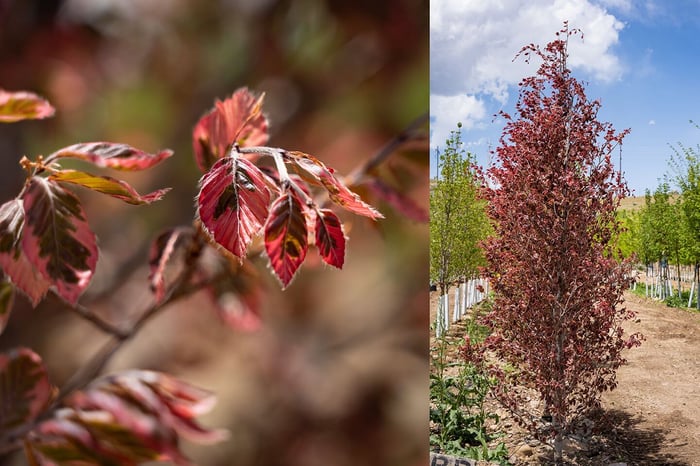 Fagus sylvatica 'Tricolor' Tricolor Beech
Fagus sylvatica 'Tricolor' Tricolor Beech
Beech
Beech trees are strong, beautiful trees and they are a heavy favorite among tree enthusiasts. They grow in various sizes and shapes, and their leaves can be either green, purple, or tri-color! They’re nothing at all like quaking aspens, but you’ll love these stunning trees in your landscape so much, you'll forget what you had planted there before. You really have to experience a beech to fully appreciate the hardy beauty it will bring to your landscape.
Hornbeam
Hornbeams have an impressive growth habit—like a giant teardrop. That makes them beautiful even in the winter when their branches are bare. Some cultivars will grow too large for smaller yards, but narrower cultivars such as Fastigiata and Frans Fontaine may be perfectly suited for your space! Depending on the cultivar, their leaves will turn yellow or orange in the fall.
This is just a sampling of trees that will thrive in your landscape where your quaking aspens used to be. Others to consider may be American Elms, Hawthorns, or Zelkovas. Whichever you decide to plant, we’re here to help walk you through the process and answer any questions you may have. There is nothing more rewarding in your landscape than the perfect tree. Let us help you find the ideal tree for your yard!
Good luck and happy gardening!

